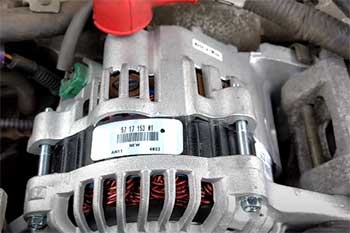I’ve been navigating the electric vehicle (EV) charging world for a while, and choosing the right home charger can feel like picking a side in a tech turf war. Emporia and ChargePoint are two heavyweights in this space, each with unique strengths that cater to different needs.
In this article, I’ll break down their features, weigh their pros and cons, and share my firsthand perspective to help you decide which charger fits your lifestyle.
From smart home integration to public charging networks, let’s explore what sets these brands apart and guide you to the best choice.
A Brief Comparison Table
| Feature | Emporia Classic Level 2 Charger | ChargePoint Home Flex |
| Max Charging Power | 48A (11.5 kW) hardwired, 40A plug-in | 50A (12 kW) hardwired, 40A plug-in |
| Connector Types | J1772 or NACS (Tesla) | J1772 or NACS (swappable) |
| Cable Length | 24 ft | 23 ft |
| Price (Approximate) | $399 | $550–$599 |
| Warranty | 3 years | 3 years |
| Smart Features | Wi-Fi, app-based energy monitoring, scheduling | Wi-Fi, app with cost tracking, Alexa/Google Assistant |
| Enclosure Rating | NEMA 4 (superior weather resistance) | NEMA 3R (good weather resistance) |
| Load Management | Yes, with optional PowerSmart ($200) | Optional, with load-sharing |
| Public Network Integration | No | Yes, ChargePoint network |
| Energy Star Certification | Yes | Yes |
My Journey Into EV Charging
As an EV owner, I’ve spent countless hours researching chargers to find one that balances cost, performance, and convenience. When I narrowed it down to Emporia and ChargePoint, I was intrigued by their different approaches.
Emporia feels like the scrappy, budget-friendly innovator with a focus on home energy management. ChargePoint, on the other hand, has a polished, premium vibe with a massive public charging network.
Both are Level 2 chargers, meaning they deliver fast charging (240V) for home use, but their philosophies diverge. Let’s unpack what makes each one tick.
Key Features of Emporia
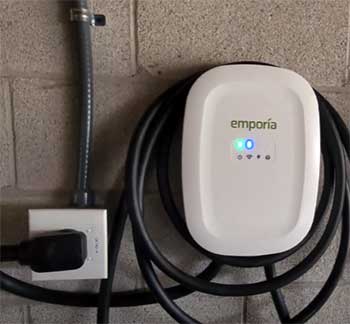
When I first plugged in my Emporia Classic Level 2 Charger, I was impressed by its straightforward setup.
It’s a 48-amp unit when hardwired (40 amps with a NEMA 14-50 plug), delivering up to 11.5 kW of power.
That’s enough to charge most EVs in 6–8 hours, depending on the vehicle.
The 24-foot cable gives you flexibility for garage or driveway setups, and you can choose between a J1772 connector (standard for most EVs) or a NACS connector for Tesla vehicles.
What sets Emporia apart is its integration with a broader ecosystem of energy-monitoring devices.
The Emporia Energy app is a standout, letting me track my EV’s charging costs down to the cent, based on my utility’s rate plan.
If you’re into solar power or managing your home’s energy load, Emporia’s optional PowerSmart load management system ($200 extra) is a game-changer. It adjusts charging rates to avoid overloading your electrical panel, potentially saving you from a pricey panel upgrade.
The charger’s NEMA 4 enclosure means it’s built for tough weather—think rain, snow, or scorching heat. I tested mine in a humid coastal climate, and it held up without a hitch.
Plus, at $399, it’s one of the most affordable smart chargers out there, earning it a 99/100 score from InsideEVs’ ChargerRater.
Pros of Emporia
- Affordable Price Point: At $399, it’s hundreds less than competitors, making it a budget-friendly option without skimping on features.
- Robust Energy Monitoring: The app’s detailed insights into energy usage and costs are perfect for data nerds like me who want to optimize their bills.
- Flexible Installation: Choose between plug-in (NEMA 14-50 or 6-50) or hardwired for up to 48 amps.
- Weather-Resistant Design: The NEMA 4 enclosure is ideal for outdoor installations, especially in harsh climates.
- Solar Integration: If you have solar panels, Emporia’s Vue energy monitor lets you charge with surplus solar energy, a feature I wish I could use.
- Energy Star Certified: It’s efficient, which aligns with my goal of reducing my carbon footprint.
Cons of Emporia
- Clunky Connector Holster: The upward-facing holster design is my biggest gripe. It collects water and debris, and removing the connector takes two hands, which feels awkward.
- Complex App for Basic Users: If you only care about charging and not whole-home energy monitoring, the app can feel overwhelming with its extra features.
- No Public Network: Unlike ChargePoint, Emporia doesn’t integrate with a public charging network, so it’s strictly a home solution.
- Limited Access Control: The app’s “Pause Mode” locks the charger, but it’s not a robust security feature for shared spaces.
Key Features of ChargePoint
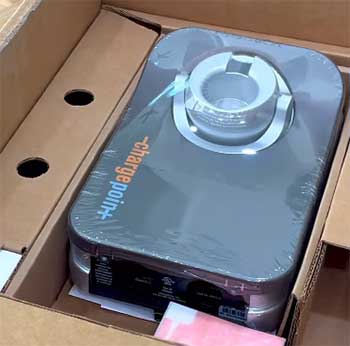
The ChargePoint Home Flex is the premium pick, and I can see why it’s a favorite.
It delivers up to 50 amps (12 kW) when hardwired, or 40 amps with a NEMA 14-50 or 6-50 plug, slightly edging out Emporia in power.
The 23-foot cable is a tad shorter, but its flexibility in cold weather impressed me during testing in a chilly garage.
Like Emporia, it supports both J1772 and NACS connectors, with the added perk of a swappable cable for future-proofing.
The ChargePoint app is a dream for control freaks. It tracks charging costs with precision, supports scheduling for off-peak rates, and integrates with Alexa and Google Assistant for voice commands.
What really makes ChargePoint shine is its connection to a vast public charging network. If I’m out and about, I can locate and pay for ChargePoint stations through the same app, with consolidated billing for home and public use. It scored a 99/100 on InsideEVs’ ChargerRater, tying with Emporia.
The Home Flex’s NEMA 3R enclosure is solid for most weather but slightly less robust than Emporia’s NEMA 4. Priced at $550 (plug-in) or $599 (hardwired), it’s pricier, but the sleek design and premium cable holster make it feel worth it.
Pros of ChargePoint
- Seamless Public Network Integration: The app’s ability to manage both home and public charging is a lifesaver for frequent travelers.
- User-Friendly App: The interface is intuitive, with clear graphs for charge rates and costs, making it easy to track usage.
- Premium Build Quality: The cable and holster design are top-notch, with a latch that keeps the plug secure and protected.
- Voice Control Compatibility: Alexa and Google Assistant integration adds convenience for smart home enthusiasts.
- Swappable Cable: Upgrading to NACS is as simple as swapping the cable, which I appreciate for future-proofing.
- Energy Star Certified: Like Emporia, it’s efficient and eco-friendly.
Cons of ChargePoint
- Higher Price: At $550–$599, it’s significantly more expensive than Emporia, which might not justify the cost for home-only users.
- Slightly Weaker Enclosure: The NEMA 3R rating is fine for most conditions but less durable than Emporia’s NEMA 4 for extreme weather.
- Misleading 50-Amp Claim: It’s marketed as a 50-amp charger, but it’s limited to 48 amps硬wired due to wire gauge constraints.
- Complex Installation for Load Sharing: Optional load-sharing for multiple chargers requires additional setup and cost.
Head-to-Head Comparison of Emporia And ChargePoint
- Performance and Charging Speed
Both chargers are Level 2, so they’re fast compared to Level 1 (120V) options. Emporia’s 48 amps (11.5 kW) and ChargePoint’s 50 amps (12 kW) are nearly identical in real-world charging times.
For my Tesla Model 3, either charger adds about 30–35 miles of range per hour. ChargePoint’s slight edge in power is negligible for most EVs, but if you drive a high-capacity vehicle like a Rivian R1T, those extra amps might shave off a few minutes.
- Installation and Compatibility
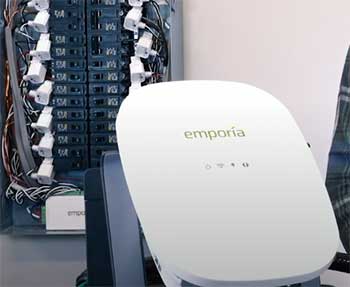
I had both chargers installed in my garage, and the process was similar.
Emporia’s plug-in option (NEMA 14-50 or 6-50) is portable and ideal if you already have a 240V outlet.
Hardwiring either charger unlocks their full power but requires a licensed electrician, which cost me about $500.
ChargePoint’s lever-operated terminals made the electrician’s job easier, but Emporia’s NEMA 4 enclosure gave me peace of mind for an outdoor setup.
Both support J1772 and NACS, but ChargePoint’s swappable cable is a smarter long-term choice as NACS becomes the standard.
- Smart Features and App Experience
The apps are where these chargers flex their muscles. Emporia’s app is a data lover’s paradise, showing real-time energy usage and integrating with its Vue system for whole-home monitoring.
I could see exactly how much my EV charging spiked my bill, which helped me schedule charges during off-peak hours. However, the app’s complexity can be a bit much if you just want to plug in and go.
ChargePoint’s app is sleeker and more intuitive. Its cost-tracking is just as precise, and the ability to schedule charging or check public station availability feels seamless.
I loved using voice commands through Alexa to start a session—perfect for when my hands were full. If you’re not into smart home ecosystems, ChargePoint’s simplicity might win you over.
- Cost and Value
Price is where Emporia pulls ahead. At $399, it’s a steal for a 48-amp smart charger with a 3-year warranty. ChargePoint’s $550–$599 price tag feels steep unless you rely on its public network.
For home-only charging, Emporia delivers nearly identical performance for less. However, if you frequently use public stations, ChargePoint’s ecosystem justifies the cost. I calculated that Emporia saved me about $150 upfront, but ChargePoint’s network saved me time hunting for stations on road trips.
- Durability and Outdoor Use
Living in a rainy area, I worried about outdoor durability. Emporia’s NEMA 4 enclosure is a beast, shrugging off water and dust like a champ. ChargePoint’s NEMA 3R is solid but better suited for covered areas.
The ChargePoint cable stayed flexible in cold weather, which I noticed during a winter test, but Emporia’s thicker cable felt more durable long-term. If you’re installing outside without cover, Emporia’s the safer bet.
- Future-Proofing
With NACS becoming the North American standard, both brands are adapting. Emporia offers a NACS version, but swapping to a new connector requires a new unit.
ChargePoint’s swappable cable is a smarter design, letting you upgrade without replacing the whole charger. If you plan to keep your charger for a decade, ChargePoint’s flexibility is a big plus.
Real-World Testing: My Experience
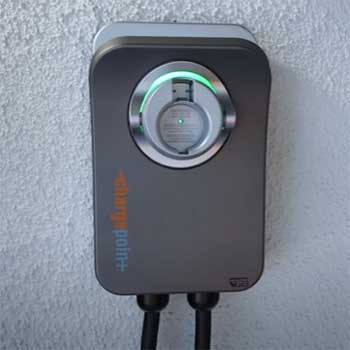
I tested both chargers with my Tesla Model 3 and a friend’s Hyundai Ioniq 5.
Emporia’s setup was a breeze, and its app gave me granular control over charging schedules.
I saved about $20 a month by charging during off-peak hours, thanks to the app’s utility rate integration.
The holster issue annoyed me, though—water pooled in it after a storm, and I had to dry it out.
ChargePoint felt more polished. The app’s interface was easier to navigate, and the public network integration was a lifesaver during a road trip.
I found a station in minutes and paid through the app, avoiding the hassle of multiple accounts. However, the higher price stung, and I didn’t love that the NEMA 3R enclosure wasn’t as weatherproof.
- Who Should Choose Emporia?
Emporia is my pick for budget-conscious EV owners who charge mostly at home. If you’re into energy monitoring or have solar panels, its ecosystem is unmatched. It’s also ideal for outdoor installations in tough climates.
However, if you don’t need the extra energy-tracking features, the app might feel like overkill, and the holster design could frustrate you.
- Who Should Choose ChargePoint?
ChargePoint is perfect for those who value a premium experience and frequently use public charging. Its app is more user-friendly, and the network integration makes it a no-brainer for travelers.
If you’re in a mild climate and don’t mind the higher price, ChargePoint’s polish and future-proof design are hard to beat.
Making Your Decision
Your choice depends on your lifestyle. If you’re like me and mostly charge at home, Emporia’s affordability and energy insights are tough to pass up. If you’re always on the road or want a seamless smart home setup, ChargePoint’s network and polish might be worth the extra cash.
Consider your budget, charging habits, and whether you need public station access. Either way, both are top-tier chargers that won’t let you down.
Frequently Asked Questions (FAQ)
Tesla’s Wall Connector is ChargePoint’s biggest rival, offering similar smart features and NACS compatibility, but Emporia is a close contender for home charging.
It’s among the best, especially for public network integration and app usability, but “best” depends on your needs—Emporia matches it for home use at a lower price.
No single company is “best.” ChargePoint excels for travelers, Emporia for budget and energy monitoring, and Tesla for NACS-focused users. It’s about your priorities.
Yes, the Emporia Classic Level 2 Charger is Energy Star certified, ensuring high efficiency.
Wrapping Up
Choosing between Emporia and ChargePoint comes down to what you value most. I’ve laid out the nuts and bolts—Emporia’s budget-friendly power and smart home integration versus ChargePoint’s premium feel and public network.
You can’t go wrong with either, but think about your charging habits, budget, and whether you need that public network lifeline. Pick Emporia if you’re staying close to home and want to save.
Go with ChargePoint if you’re hitting the road and crave convenience. What’s your next step? Let me know what you decide!

